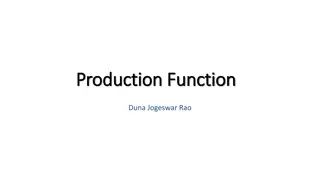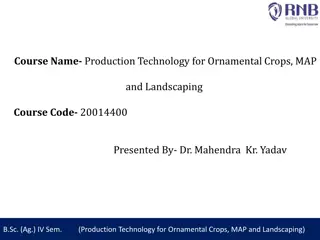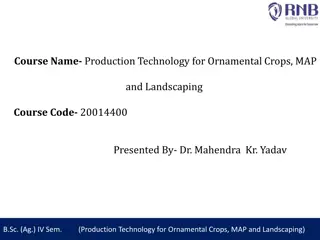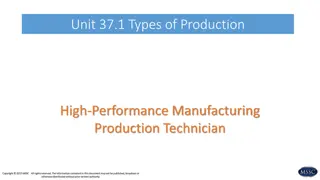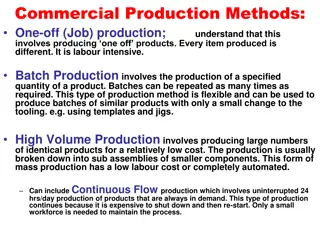PRODUCTION TECHNOLOGY OF BROADBEAN
Broad beans, scientifically known as Vicia faba L., are a valuable crop with significant nutritional value. This article covers the botanical description, nutritive value, cultivation practices, climatic requirements, and more for broad beans. Learn about the plant's growth habits, preferred soil conditions, and tips for successful cultivation. Explore the benefits of broad beans as a food source and their versatility in culinary applications.
Download Presentation

Please find below an Image/Link to download the presentation.
The content on the website is provided AS IS for your information and personal use only. It may not be sold, licensed, or shared on other websites without obtaining consent from the author. Download presentation by click this link. If you encounter any issues during the download, it is possible that the publisher has removed the file from their server.
E N D
Presentation Transcript
PRODUCTION TECHNOLOGY OF BROADBEAN G.Harika
PRODUCTION TECHNOLOGY OF BROADBEAN
Botanical description Botanical description Scientific Name : Vicia faba L. Chromosome Number : 2n=12, 14 Family : Fabaceae Centre of Origin : North Africa
Nutritive Value (per 100g of edible portion) - 48kcal Energy - 85.4g Moisture Protein - 4.5g - 0.1g Fat Carbohydrate - 7.2g Vit-A - 15IU - 0.08mg Thiamin Niacin - 0.8mg Ascorbic acid - 12mg - 50mg Calcium - 64mg Phosphorus Iron - 1.4mg
Broad bean (Vicia faba L.) also known as faba bean or horse bean. It is a minor leguminous crop grown in localized areas in India but is an important food crop of South America. It is the. only bean grown as a winter crop. Broad beans are used as green, shelled and dry beans and as a feed for livestock
DESCRIPTION OF PLANT : Annual herb and plants are erect with height ranging from 50cm to 180cm. Plants have square ,erect stems and large leaves and broad upright pods borne in leaf axils.(5-7 pods) Flowers are white coloured that is splotched with brown coloured spot and pollinated by insect.
Large immature ,succulent and fresh seeds of beans are eaten as vegetable. Seeds are rich source of protein and have anti-nutritional factors like tannins, vicine and convicine that cause FAVISM .but the harmful effects are almost removed when seeds are well cooked.
Climatic Requirements Climatic Requirements Broad bean is a hardy plant. It is grown mainly at higher altitudes where the climate is relatively cool. It is the only bean, which can withstand cold (up to 40C), therefore, it is grown as winter crop.
Soil conditions : It prefers rich, well drained loamy soil with pH range of 6.5 to 7.5. Acidic soils are not good for broad bean. It can tolerate salinity up- to some extent. Land should be prepared thoroughly by giving repeated ploughing to get fine tilth.
Varieties : Long pod type:- Aquadule Claudin, Imperial White Long pod, Masterprice Green Long Pod, Imperial Green Long pod, Red epicure . Windsor Type : Imperial White Windsor, Giant four seeded green Windsor, Imperial Green Windsor.
Indian Varieties : Pusa Pusa Sumeet Sumeet : Plants are 75cm tall having on an average of 10 branch/plant. A plant bears about 100 pods. The pod length and thickness are 6.0cm and 1.3cm respectively. It has attractive dark green pods and borne in cluster. The average yield potential is 180q/ha. Selection BR-1 SelectionBR-2 are black and yellow seeded varieties respectively developed from Bihar state. Jawahar Viva 73-81 is a dormant type, reported from Madhya Pradesh.
The broad bean falls into 3 main categories based on length of pod : The broad bean falls into 3 main categories based on length of pod : 1. Long pod broad beans : They have about 8 beans in each pods. Early long pod varieties produces heavy crop under moist conditions.
2 . Short pod broad beans : They are somewhat smaller in size than long pod beans and have 3 to 5 beans per each pod.
Dwarf broad beans : They can be grown as a pot herbs and may have 2 to 3 beans per pod .
Seed Rate Seed Rate : :70 - 100 kg/ha Sowing is done in the month of September-October and February-March. Seeds are sown in shallow furrows of 15 cm width formed at a spacing of 75 cm. Each furrow two rows of seeds are sown at a spacing of 25cm in a zigzag manner along the furrows. It can be sown in a single row system with spacing of 45x15 cm
MANURING AND FERTILIZERS : About 10-15 tonnes of FYM per hectare is applied to the soil at the time of land preparation.The fertilizer application is also done before sowing, which may include 20kg N , 50kg P ,and 40kg K / ha.
USE OF PLANT GROWTH REGULATORS : Certain plant regulators like PCPA @ 2ppm, alpha- naphthyl acetomide @ 2-25ppm or beta-naphthoxy acetic acid @ 5-25ppm. When normally pods do not set, induce fruit set. Thus by spraying some plant regulators, higher, early and total yield can be obtained.
IRRIGATION AND CULTURAL PRACTICES : IRRIGATION AND CULTURAL PRACTICES : Immediately after sowing, the field has to be irrigated. This is followed by light irrigation on the third day. Thereafter, light irrigation should be given at a regular interval of 12-15days. Regular intercultural operations should be carried out by hand weeding and hoeing to keep the weeds under check and to provide a good environment for crop growth.
Tall varieties may be given support with wooden sticks or twigs against wind. Place stakes or canes at one meter interval on both sides of the double rows close to the beans. Then tie around the stakes with twine 30cm to 60cm above the ground
Harvesting and Yield : Harvesting and Yield : The pods are ready for harvesting in 3-4months for spring sowing and 6-7 months for autumn sowing. Very young pods are preferred by most people. The beans are harvested at the green-shell stage as needed for home use or for market and those remaining on the plant are used as dry-shell beans. Pod yield of 7-10tonnes/ha Green bean yield of 1.8-2 tonnes /ha is expected
Plant Protection : Plant Protection : INSECT PESTS: Aphids, thrips and mites are some of the insect pests attacking bean crop. Spraying 2ml/litre of Dimethoate (Rogor) or Monocrotophos for the control of thrips and stem fly. Mites can be controlled by spraying Dicofol (kelthane) 2.5ml/litre.
Diseases : Diseases : Yellow mosaic, anthracnose, Phytophthora pod rot, rust, angular leaf spot, ashy stem blight and rhizoctonia root rot are some of the diseases affecting the crop. The diseases can be effectively controlled by spraying Blitox or Difoliton at the rate of 2kg/litre. Root rot can be controlled by drenching captan 2g/litre.













